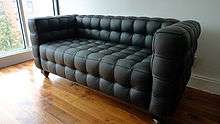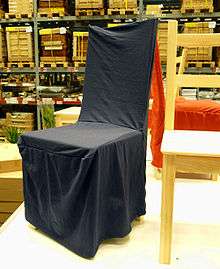Couch

A couch (British English, U.S. English),[1] also known as a sofa or settee (Canadian English and British English), is a piece of furniture for seating two or three people in the form of a bench, with armrests, which is partially or entirely upholstered, and often fitted with springs and tailored cushions.[2][3] Although a couch is used primarily for seating, it may be used for sleeping.[4] In homes, couches are normally found in the family room, living room, den, or the lounge. They are sometimes also found in non-residential settings such as hotels, lobbies of commercial offices, waiting rooms, and bars.
History of the term
The term couch is predominantly used in Ireland, North America, South Africa and Australia, whereas the terms sofa and settee (U and non-U) are generally used in the United Kingdom. The word couch originated in Middle English from the Old French noun couche, which derived from the verb meaning "to lie down".[5] It originally denoted an item of furniture for lying or sleeping on,[6][7] somewhat like a chaise longue, but now refers to sofas in general. The word sofa comes from Turkish and is derived from the Arabic word suffa ("wool"), originating in the Aramaic word sippa ("mat").[8] Joseph Pubillones in A Little Shimmer Goes a Long Way specifies that the main difference between the couch and the sofa is that "couches can be used for reclining or laying upon" so a couch would "best be used to describe an upholstered piece in a family room", while the term sofa "used predominantly in England and Ireland denotes a tone of formality, hence a sofa is more appropriate word for the upholstered piece in the living room".[9]
The word settee or setee comes from the Old English word setl, which was used to describe long benches with high backs and arms, but is now generally used to describe upholstered seating.
Other terms which can be synonymous with the above definition are chesterfield (Canada), divan, davenport, lounge, and canapé.[3]
Types
The most common types of couches are the two-seater, sometimes referred to as a loveseat, designed for seating two persons, and the sofa, which has two or more cushion seats. A sectional sofa, often just referred to as a "sectional", is formed from multiple sections (typically two, three, and four) and usually includes at least two pieces which join at an angle of 90 degrees or slightly greater, used to wrap around walls or other furniture.
Other variants include the divan, the fainting couch (backless or partial-backed) and the canapé (an ornamental three-seater). To conserve space, some sofas double as beds in the form of sofa beds, daybeds, or futons.

A furniture set consisting of a sofa with two matching chairs[10] is known as a "chesterfield suite"[11] or "living-room suite".[12] Also in the UK, the word chesterfield meant any couch in the 1900s, but now describes a deep buttoned sofa, usually made from leather, with arms and back of the same height.[13] The first leather chesterfield sofa, with its distinctive deep buttoned, quilted leather upholstery and lower seat base, was commissioned by Philip Stanhope, 4th Earl of Chesterfield (1694–1773).[13]
In Canadian English, chesterfield as equivalent to a couch or sofa[14] is widespread among older Canadians, but the term is quickly vanishing according to one survey done in the Golden Horseshoe region of Ontario in 1992.[15]
Materials

A couch consists of the frame, the padding and the covering. The frame is usually made of wood, but can also be made of steel, plastic or laminated boards. Sofa padding is made from foam, down, feathers, fabric or a combination thereof. Sofa coverings are usually made out of soft leather, corduroy or linen fabric coverings.
Image gallery
 A red two-seater upholstered loveseat
A red two-seater upholstered loveseat A beige couch
A beige couch Sofa steel production malayer
Sofa steel production malayer- A beige couch in a couch shop
 English Settee, c. 1770
English Settee, c. 1770
See also
| Look up couch in Wiktionary, the free dictionary. |
- Bean bag
- Couch potato
- Confidante
- Davenport (sofa)
- Divan (furniture)
- Ottoman (furniture)
- Settle (furniture), wooden furniture with similar usage
- Slipcover
- Wing chair
- Window seat (type of sofa)
Notes
- ↑ The Oxford English Reference Dictionary, 2nd edition, editors Judy Peasrall, Bill Trumble, Oxford University Press
- ↑ "Couch". Dictionary.com (American Heritage Dictionary). Retrieved 2012-08-15.
- 1 2 "Couch". The Free Dictionary By Farlex. Retrieved 2012-05-12.
- ↑ "Couch". Merriam-Webster. Retrieved 2012-05-12.
- ↑ AMHER, couch: Middle English from Old French culche, couche > couchier, coucher.
- ↑ Harrison, Molly (1971). People and furniture: a social background to the English home. Ernest Benn. p. 55. ISBN 978-0-8747-10373.
- ↑ Lennox, Doug (2007). "Home, Hearth, and Family". Now You Know Big Book of Answers. Dundurn. ISBN 978-1-55002-741-9. Retrieved June 20, 2018 – via Google Books.
- ↑ AMHER, sofa: Turkish, from Arabic suffa, from Aramaic sippa, sippəta.
- ↑ Pubillones, Joseph (2016). "Sofa, Couch or Divan?". A Little Shimmer Goes a Long Way. p. 30. ISBN 978-1-9456-30330. Retrieved June 20, 2018 – via Google Books.
- ↑ "Three-piece-suite". Cambridge Dictionaries Online. Retrieved 2012-05-12.
- ↑ "Chesterfield suite". Merriam-Webster. Retrieved 2012-05-12.
- ↑ "Living room suite". Cambridge Dictionaries Online. Retrieved 2012-05-12.
- 1 2 "A Complete Guide to Chesterfield Sofas". designersofas4u.co.uk. 2018. Retrieved June 20, 2018.
- ↑ "Chesterfield". Canadaspacedictionary. Retrieved 2012-05-12.
- ↑ Chambers, J. K. "The Canada-U.S. border as a vanishing isogloss: the evidence of chesterfield". Journal of English Linguistics; 23 (1995): 156–66, excerpt at chass.utoronto.ca.
References
- John Gloag, A Short Dictionary of Furniture rev. ed. 1962. (London: Allen & Unwin)
Further reading
- Campbell, Gordon (2006). "Sofa". The Grove Encyclopedia of Decorative Arts. Volume 2. Oxford University Press. p. 369. ISBN 9780195189483.